
Text and photo images
©2013 Richard Leonard.

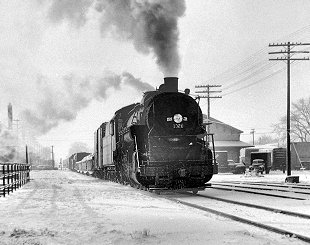 In 1954 our family moved from Detroit to Bloomington in central Illinois, where my father became a professor at Illinois Wesleyan University. The move brought us into a new railroad orbit. Bloomington was served by four railroads: the Gulf, Mobile & Ohio's former "Alton Route," the Nickel Plate's Peoria branch, New York Central's subsidiary Peoria & Eastern, and the Illinois Central. At that time, in our area, the Illinois Central was still 100 percent steam for freight service, and I (still in pre-driving mode) made many a visit to trackside via bicycle.
In 1954 our family moved from Detroit to Bloomington in central Illinois, where my father became a professor at Illinois Wesleyan University. The move brought us into a new railroad orbit. Bloomington was served by four railroads: the Gulf, Mobile & Ohio's former "Alton Route," the Nickel Plate's Peoria branch, New York Central's subsidiary Peoria & Eastern, and the Illinois Central. At that time, in our area, the Illinois Central was still 100 percent steam for freight service, and I (still in pre-driving mode) made many a visit to trackside via bicycle.
Bloomington was a junction between the Illinois Central's original main line from southern Illinois to Freeport, where it intersected the Iowa main line, and a branch from Bloomington to Kankakee (the tracks actually diverged just north of the Bloomington-Normal city boundary). Today both lines are mostly abandoned, though portions are still served by short line or industrial operators. The Freeport line — also known as the "charter line" or "Gruber line" — was a secondary route that still saw long freights. I once counted a 101-car train behind a 2-10-2. The branch line was served by Consolidations.
In this snowy scene at right, from December 1954, 2-8-2 No. 1328 pulls northward through Bloomington across the East Washington Street overpass. The IC freight depot is in the background. For details about the locomotives on this page I am indebted to Ray Breyer, who very kindly sent me a spreadsheet of his exhaustive Illinois Central all-time steam roster.
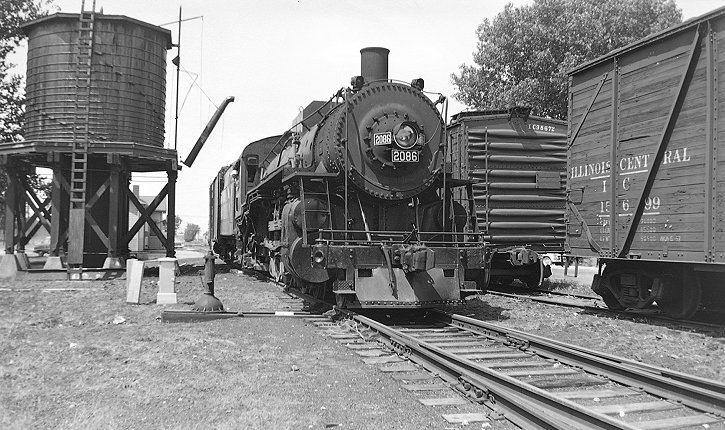
My first chance to photograph Illinois Central steam came on a visit to Bloomington in July 1954. I accompanied my father on a preliminary trip from our home in Detroit to the college campus where he was to teach. At Pontiac, Illinois, we encountered Pacific No. 2086 switching cars on the branch that ran from a junction with the "charter line" just south of Minonk to a connection with the Bloomington-to-Kankakee branch near Kempton. I took several photos of this low-drivered Paducah Shops rebuild, including the head-on view above featuring the vintage wooden-staved water tank and the outside-braced IC box car. Below, we see the locomotive taking on water before continuing its eastward trek.
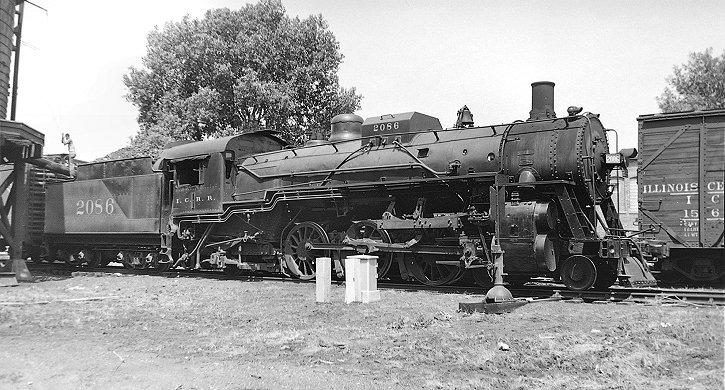
No. 2086 was built by the American Locomotive Company in 1912 as the Illinois Central's No. 1099, and was renumbered in 1942 or 1943 in connection with her extensive rebuild in the Paducah shops. Her 75½-inch drivers, suitable for higher-speed passenger service for which she was no longer needed, were reduced to 61 inches. She had 25x25-inch cylinders and carried 215 pounds per square inch of boiler pressure. As rebuilt she exerted 48,683 pounds of tractive effort and weighed 248,733 pounds. Her service life ended about a year after this photo was taken when she was scrapped. The original appearance of these locomotives is shown in the image below, taken from a 1913 bulletin of the American Locomotive Company featuring 42 orders for Pacific type locomotives delivered to North American railroads.
.jpg)
Normally the 4-6-2 was considered a passenger locomotive, but several North American railroads also used them in local freight service. I had often seen Pacifics performing freight duty on the Grand Trunk Western during my years in Michigan. No. 2086, filmed by Jerry Carson, can be seen briefly in the Green Frog video-DVD Steam in the 50s, Volume I.
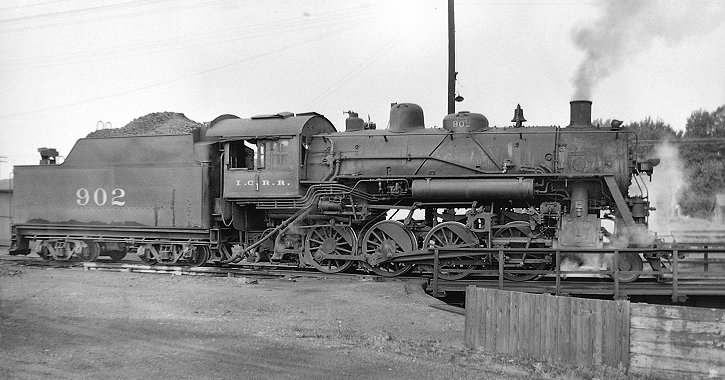
Branch line power between Bloomington and Kankakee consisted of Consolidation or 2-8-0 type locomotives in the 900 series. To accommodate the needs of these engines, the Illinois Central maintained a small servicing facility in Bloomington consisting of an engine shed, a coal conveyor, and a turntable powered by compressed air from the locomotive. Above, No. 902 eases onto the turntable to be positioned for its return trip to Kankakee in August, 1955, only four month before she was scrapped. Incidentally, during this period No. 902 was filmed in Kankakee by John Szwajkart, and is seen briefly in the Mark I video The Midland and Two Centrals. She also appears briefly in the Herron Rail video-DVD Illinois Central Steam Finale. Below, No. 908 pauses at the coal conveyor in June 1956; she lasted till 1960.
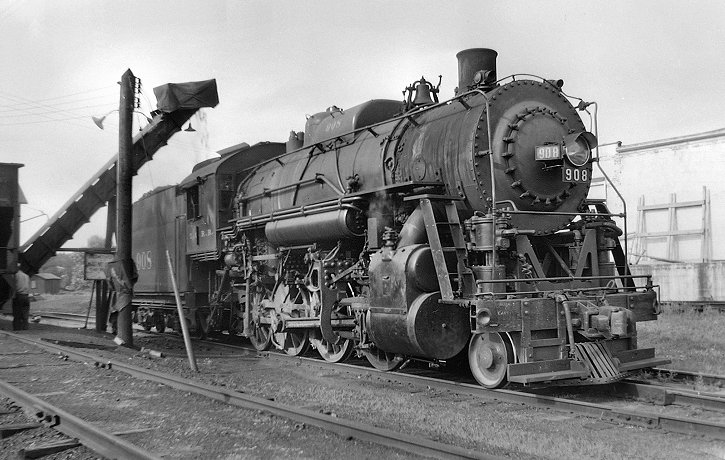
The Consolidation type was the most numerous of all North American steam locomotives, but few were constructed for domestic use after 1920. Most railroads demoted their older locomotives to branch line and local service, where they ran out their remaining days with little modernization. Not so the Illinois Central, which extensively rebuilt its fleet of locomotives, including smaller power like 4-6-2s and 2-8-0s, increasing their tractive effort and efficiency for the needs of a later era. These 900-series Consolidations were products of Baldwin Locomotive Works; No. 908 was erected in 1909 as 944, and No. 902 two years later as 966. They were renumbered during their 1943 rebuilding, during which they received stokers, unusual appliances for a 2-8-0 but no doubt much appreciated by their firemen. As rebuilt No. 902 had 22½x30-inch cylinders, 62-inch drivers and 235 pounds per square inch of boiler pressure; she produced 48,930 pounds of tractive effort and weighed 244,000 pounds. The rebuilt No. 908 had the same driver diameter and boiler pressure, but featured 27x30-inch cylinders, raising her tractive effort to 70,460 pounds — very high for a Consolidation. The locomotive weighed 249,000 pounds minus tender
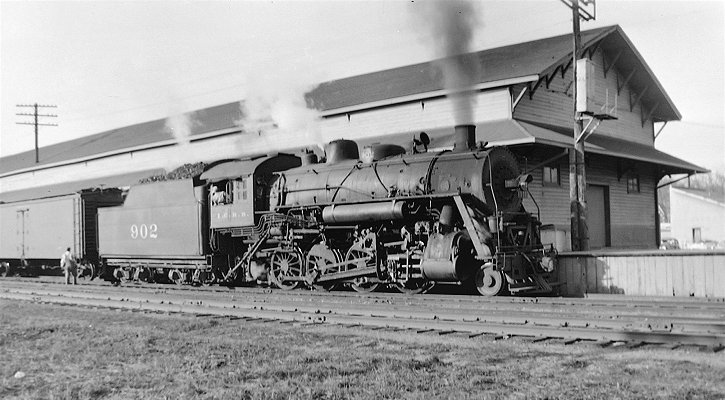
The Consolidations that ran between Bloomington and Kankakee also handled local industrial and yard switching in Bloomington-Normal. Above, No. 902 pauses at the Bloomington freight depot in May, 1955. Below we see No. 908 at Dean Tower in July, 1957, near the end of the use of steam power here. Dean was where the Illinois Central crossed the Nickel Plate and the Peoria & Eastern. Perhaps No. 908 had been sent there to handle transfer traffic between the railroads.
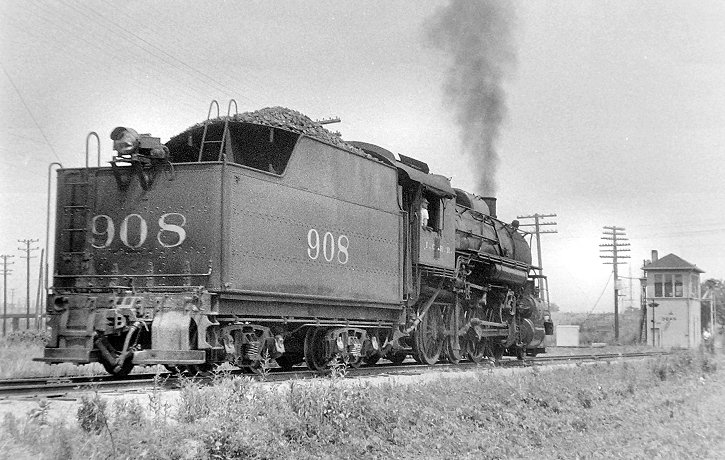
Like another "Central," the New York Central, the Illinois Central favored the 4-8-2 type for main line dual freight and passenger service. It owned a total of 136 of this type, more than any other railroad except for the New York Central's 600 Mohawks and the Pennsylvania's 301 M1s. These locomotives hustled merchandise and perishable freight trains over the celebrated three-track main through Illinois, the center track permitting faster traffic including IC's diesel-powered passenger trains to overtake slower trains going the same direction. Diverging at Gilman, a single-track main line carried Chicago-St. Louis traffic pulled by the same powerful locomotives, which were changed and serviced at Clinton, Illinois, about 23 miles south of our home in Bloomington.
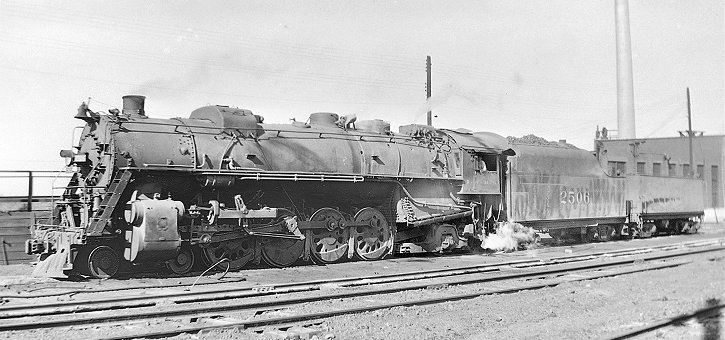
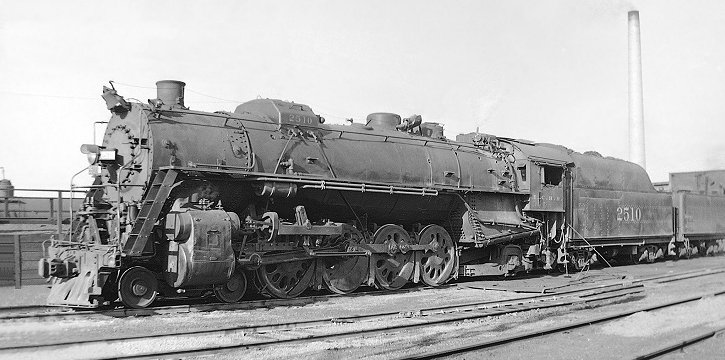
A visit to the engine terminal at Clinton in October 1954 yielded shots of several of these big 4-8-2s, including Nos. 2506 and 2510 (above) and No. 2554 (below). The Illinois Central's own Paducah Shops built the 2500-class locomotives, beginning in 1938. They had 70-inch disc drivers and 30x30-inch cylinders, with a boiler pressure of 240 pounds per square inch. They weighed 409,500 pounds and exerted 73,768 pounds of tractive effort.
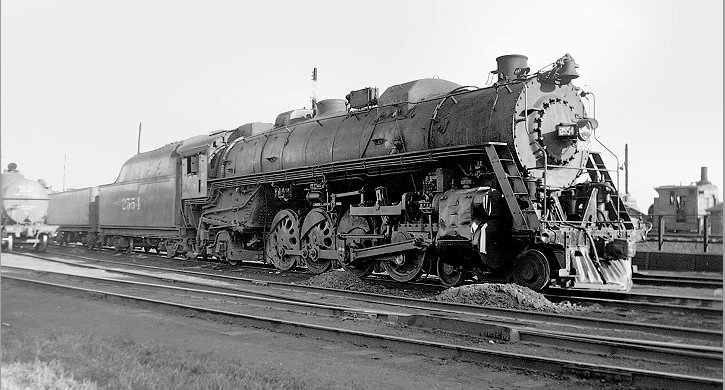
Paducah built 56 of these 4-8-2s using boilers from some of its 125 heavy USRA 2-10-2s. The 2500s were clean-lined and well proportioned locomotives, except that most of them (like those shown) had a too-small tender supplemented by an auxiliary water tank. Nos. 2506 and 2510 were scrapped in 1959, and No. 2554 in 1960. Two representatives of the 2500 class survive, No. 2500 in Centralia, llinois and No. 2542 in McComb, Mississippi.
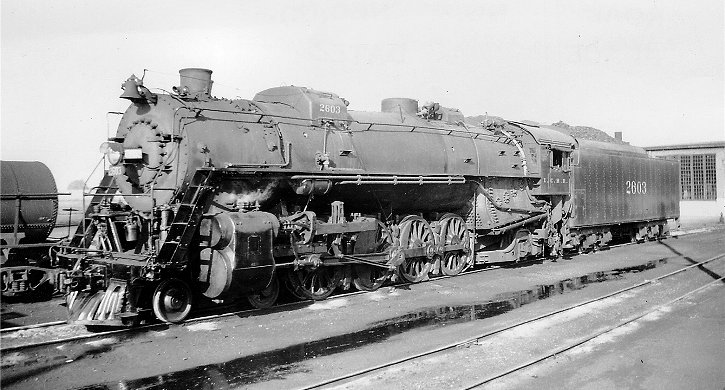
In 1942-43 Paducah built twenty additional new 4-8-2s in the 2600 class that were among the heaviest Mountain type locomotives, as most railroads called them, weighing in at 423,893 pounds. (However, viewer Ted Richardson has pointed out that the Frisco, or St. Louis-San Francisco Railway, had two classes of Mountains rebuilt from 2-10-2s that were heavier, one topping out at 449,000 pounds.) They shared the 70-inch driver diameter of the 2500 class, but had 28x30-inch cylinders and sustained a boiler pressure of 275 pounds resulting in 78,584 pounds of tractive effort. They were the last steam locomotives built new for service on the Illinois Central. On our autumn, 1954 visit to Clinton we found No. 2603 representing the class. Some members of the class featured disk drivers, but No. 2603's drivers appear to be of the web-spoked type. None of these locomotives have been preserved.
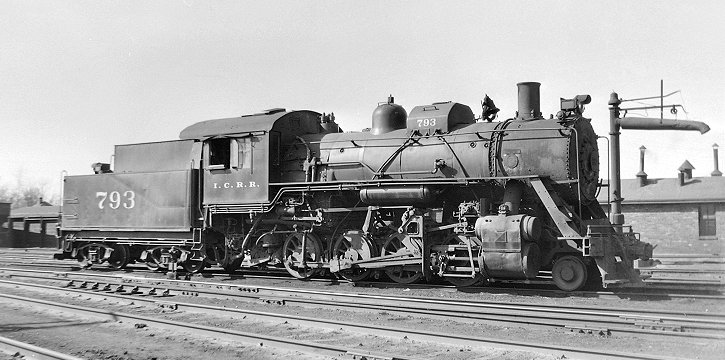
Our 1954 visit to the Clinton terminal yielded a few shots of older and smaller locomotives including this view of Consolidation No. 793, out of service awaiting its impending demise at the scrappers. Built in 1903 by ALCo's Cooke Locomotive and Machine Works in Paterson, New Jersey, she was originally No. 103 of the Chicago Union Transfer and became the IC's No. 644 in 1904, assuming her final number in 1943. As rebuilt by the Paducah Shops No. 793 had 51-inch drivers, cylinders of 22x26 inches, and 230 pounds of boiler pressure, which produced 51,000 pounds of tractive effort.
Customary power through Bloomington on the Freeport line in the mid-1950s was a 2-8-2 or Mikado in the 1300 or 1500 series, although an occasional 2-10-2 could also be seen. "Mike" No. 1362, pictured in September, 1954, shows evidence of its Paducah Shops rebuilding in the squared-off sand dome (behind the bell) and the disc main driver. Pausing to take on water at Bloomington, she is headed northward toward Freeport. No. 1362 began life as No. 1874, a Lima Locomotive Works product of 1918. This engine had 27x30-inch cylinders and 63½-inch drivers, and carried a boiler pressure of 185 pounds per square inch. Locomotive weight was 282,700 pounds, and she mustered a tractive effort of 54,158 pounds. When I photographed No. 1362 she had less than a year of service left, going to the torch in May 1955.
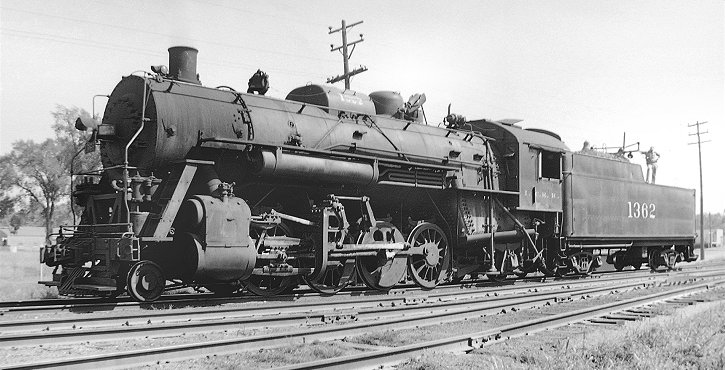
On this site I have tried to avoid showing locomotives that were "dead" or removed from service when I photographed them, unless their rods were intact. The following image is an exception to this rule because 2-8-2 No. 2199 was a one-of-a-kind locomotive. The Illinois Central's extensive Paducah rebuilding program remodeled many 2-8-2s using cylinders and running gear from 2-10-2s. However, No. 2199 received its frame and running gear from Lima 2-8-4 No. 7038, which had given up its boiler to create the IC's lone 4-6-4 No. 1 (later 2499). The hybrid No. 2199 began life in 1937 as No. 2020 and was renumbered in 1942. It had 27½x30-inch cylinders and 63½-inch drivers, and its boiler — originally from 1914-built 2-8-2 No. 1549 — carried 225 pounds per square inch of pressure. This engine weighed 326,500 pounds and developed 68,330 pounds of tractive force. I took this photo of No. 2199 in a line of scrapyard-bound locomotives at Clinton, Illinois in May 1955.
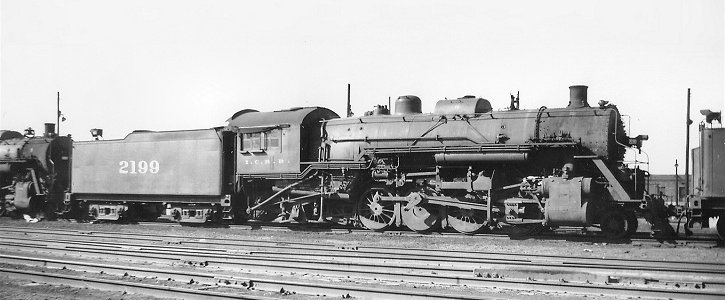
Below, Mikado No. 1518 performs a midday switching move in September, 1954 somewhere within the Bloomington yard limit (viewer Brad Hanner believes it is on the spur that served Eureka Williams, Meadows Manufacturing and Cities Service fuel storage). This locomotive was built by Lima in 1923 as the Illinois Central's No. 1932 and, after carrying the number 1420 from 1940 onward, was renumbered to 1518 in 1951. She had the same dimensions as No. 1362 above. No. 1518 was taken out of service not long after this photo was taken, and I photographed her in the "dead line" at Clinton, Illinois in May 1955. But, ominous though that may have appeared, it was not the end for this engine. She went to Kentucky and was restored to service, being photographed in August 1957 heading toward Central City, and being recorded by an IC engineer in his time book on September 6 of that year. (Careful sleuthing by Mike Favre has turned up this information.) One source claims No. 1518 was the last Illinois Central steam engine in regular service; she appears in the Herron Rail video-DVD Illinois Central Steam Finale.
By 1960 only two IC Mikados, Nos. 1518 and 1537, had yet to be scrapped. No. 1537 was retired in February, but No. 1518 was chosen for preservation, beng placed on display in Paducah in 1964. (Although one source claims that locomotive is actually the eventual No. 1818, which briefly carried the number 1518 before 1949, Mike Favre's research indicates the display locomotive is indeed the "real" 1518.)
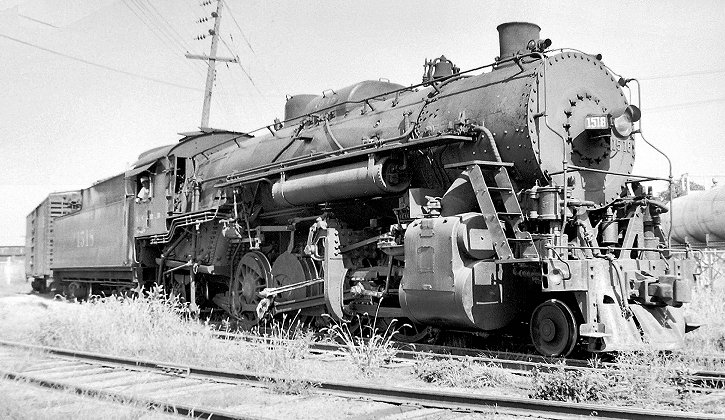
I had only about a year to photograph these locomotives. Beginning in 1955 we began to see the ubiquitous EMD "Geep" at the head of Freeport line freights. The 2-8-0s on the Bloomington to Kankakee run held on for another few years. But by the time I was photographing in 35mm there was little steam left in my home town, and I and my steam-loving friends had to travel further afield to find it.
